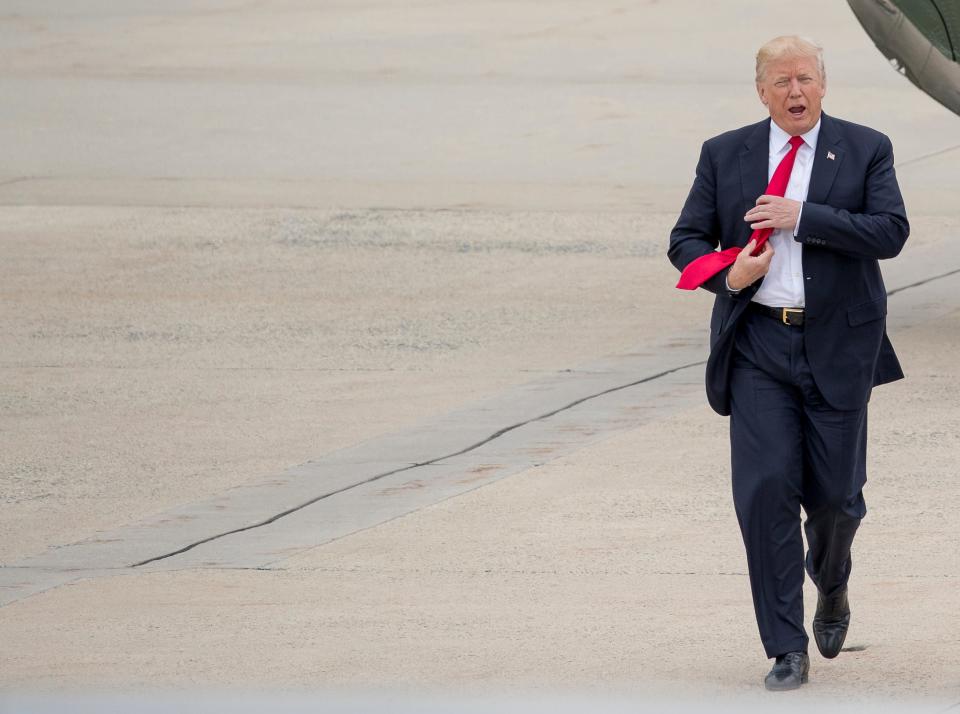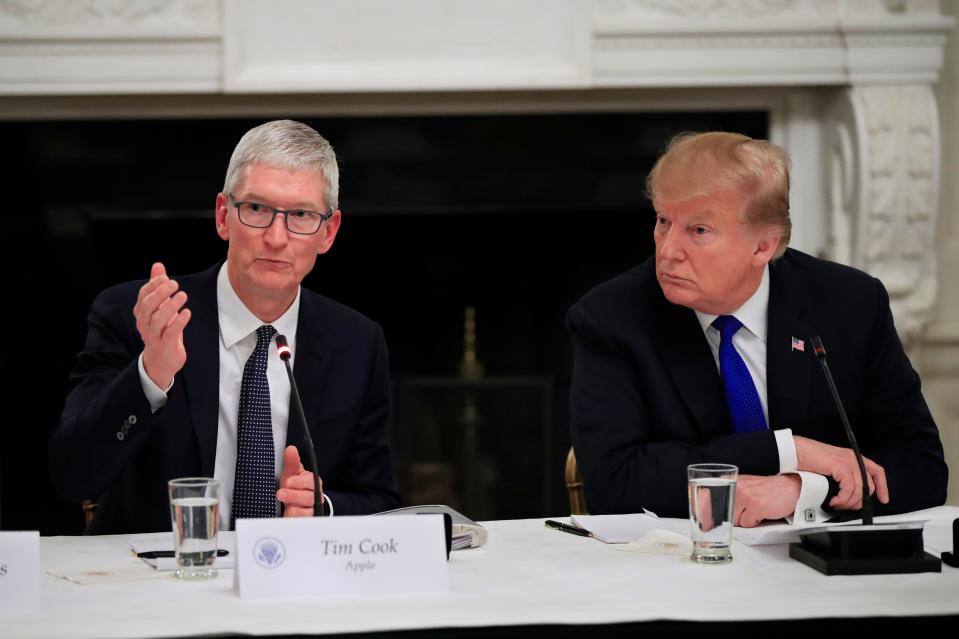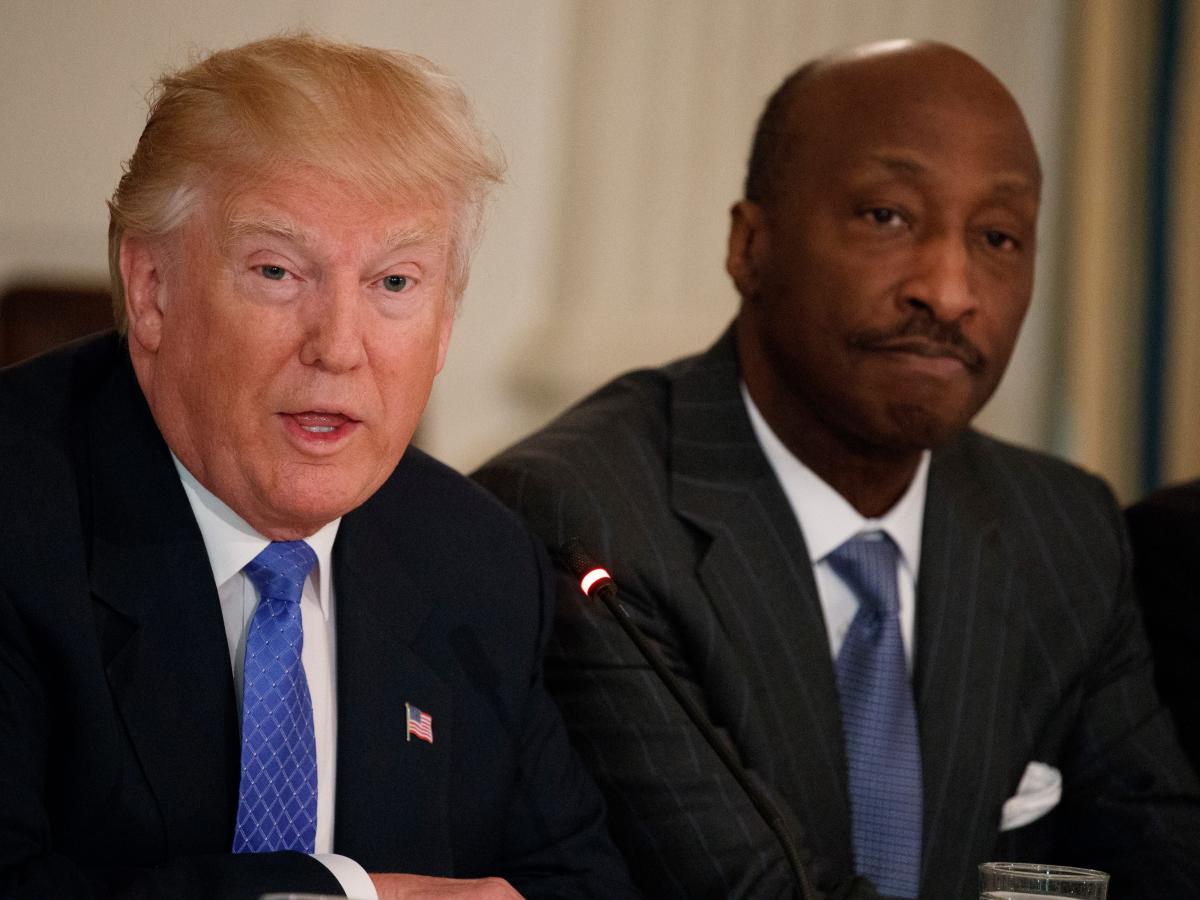-
Donald Trump’s presidency began with business leaders eager to help him rebuild the economy.
-
Many business leaders praised his tax overhaul, which lowered the corporate tax rate.
-
But after the 2017 Unite the Right rally, Trump was widely criticized for his response to the violent event.
When Donald Trump first ran for president, he promised to run the United States like a business.
“If we could run our country the way I ran my business, we would have a country you would be so proud of,” he said during an October 2016 debate with his then-opponent, former Secretary of State Hillary Clinton.
After Trump was elected to the White House, he brought with him key figures such as financier and film producer Steve Mnuchin, who became his Treasury Secretary; former Goldman Sachs President Gary Cohn, who became director of the National Economic Council; and businessman Wilbur Ross, who served as Secretary of Commerce.
Drawing on his pro-business ideology, Trump worked to reduce regulation within the federal government and signed his signature $1.5 trillion tax plan, which helped Republicans push through Congress as the majority party. The plan, which was opposed by Democrats in Congress, was the largest overhaul of the tax code in decades.
For much of the business community, the law, which reduced the corporate tax rate from 35% to 21%, was a long-awaited achievement.
But Trump’s presidency also saw some high-profile clashes that, over time, made him a polarizing figure among leaders who often agreed with him on many policy issues. As Trump touts his past stewardship of the economy heading into November, here’s a look at his relationship with business during his first term:
One of their own
Decades before Trump entered national politics, he rose to national prominence as a wealthy real estate developer and businessman. As a presidential candidate, Trump’s background was unique in that he had served neither as governor nor as a member of Congress nor had a military background.
But in a presidential year when many Republican voters were looking for a change agent, his business background gave him a big boost as a political outsider.
For many in the business world, Trump was essentially one of them. His relationship with top business leaders got off to a good start, especially after he hosted a dozen CEOs (including Tesla founder Elon Musk) at the White House during his first week in office, where he emphasized his desire to pass tax cuts.
However, Trump’s relationships with many of these leaders fell apart in the aftermath of the August 2017 Unite the Right rally in Charlottesville, Virginia, where white nationalist groups unleashed a wave of violence. Heather Heyer, a 32-year-old woman who gathered with a crowd of counter-protesters in downtown Charlottesville, was killed after a white supremacist drove into the group.
Trump tried to emphasize days after the incident that some attendees were protesting the removal of a Confederate statue and were not in Charlottesville to cause trouble, but the comments backfired spectacularly.

“You had some very bad people in that group, but you also had people who were very fine people on both sides,” he said. “I’ve condemned neo-Nazis. I’ve condemned a lot of different groups. But not all of those people were neo-Nazis, believe me. Not all of those people were white supremacists, anyway.”
Following the comments, Kenneth Frazier, then CEO of Merck, stepped down from Trump’s manufacturing board.
“America’s leaders must honor our fundamental values by clearly rejecting expressions of hatred, bigotry and group supremacy that are contrary to the American ideal that all people are created equal,” he said at the time.
Kevin Plank of Under Armour, Inge Thulin of 3M and Brian Krzanich of Intel, among others, also resigned.
Trump then abruptly dissolved the American Manufacturing Council and the Strategic and Policy Forum.
The infrastructure plan
Trump signed an executive order in July 2017 creating an infrastructure advisory council, similar to his other councils, but he ultimately ended it.
The inaction on the infrastructure council reflected Trump’s eventual inaction in advancing a comprehensive infrastructure plan, despite his claim that he would rebuild America’s roads and bridges, especially in hard-hit Rust Belt communities that were struggling to recover from factory closures and declining tax bases. .
Even the promise of an ‘Infrastructure Week’ became a long-running punchline. Trump rolled out plans to spend between $1 trillion and $1.5 trillion on infrastructure in 2017 and 2018.
But every time he tried to formulate a plan, he got sidetracked.
At a Rose Garden event in June 2017, Trump accused former FBI Director Jim Comey of lying under oath before Congress, distracting him from his intended focus on infrastructure. In August 2017, a Trump Tower event intended to provide updates on Trump’s infrastructure plan was dominated by his response to the violence in Charlottesville. And in February 2018, Trump’s infrastructure proposal took a back seat amid allegations of misconduct by two close associates.
Trump’s plans to repair the nation’s bridges, ports and railroads failed to materialize in 2018 — even though the Republican Party had full control of Congress until January 2019.
“There’s a very important election coming up, and they’re not happy with the victories we’ve had,” Trump said in 2018, attempting to shift the blame for the lack of action on infrastructure to Democrats .
Even after the 2018 midterm elections — when Democrats retook the House of Representatives but Republicans retained control of the Senate — Trump never got a major infrastructure plan through Congress.
That task became a call for his successor, President Joe Biden, who in November 2021 signed a landmark $1 trillion infrastructure bill that funded everything from port upgrades and Amtrak grants to crucial bridge repairs and high-speed broadband.
As for technology
During the 2016 presidential race, many top technology executives supported Clinton’s campaign.
But after the election, Trump invited a wide range of technology leaders to Trump Tower and expressed a desire to work with them on innovation. At the December 2016 meeting, the group discussed job creation, trade and infrastructure, according to Trump’s then-transition team.


One of the leaders present was Musk, years before he would take over Twitter and rename it X.
In June 2016, Trump met with top technology executives, including Apple’s Tim Cook and Amazon’s Jeff Bezos, to come up with a solution for overhauling the federal government’s information technology systems. But the meeting came as many leaders strongly opposed Trump’s withdrawal of the US from the Paris climate accord earlier that month. (Biden rejoined the agreement in January 2021.)
Cook told Apple employees at the time that he tried to convince Trump to stick with the deal, but said his appeal “wasn’t enough.”
In 2020, several tech leaders – including Cook – were critical of Trump’s visa restrictions that would impact highly skilled foreign workers in the sector. The Trump administration said at the time that the move was made to provide positions for American workers during the pandemic.
Cook said at the time that he was “deeply disappointed” by the move.
“Like Apple, this nation of immigrants has always found strength in our diversity, and hope in the enduring promise of the American Dream,” the executive added.
Ahead of the November election, Trump is looking to Silicon Valley – where Biden has significant support – as he looks to close a significant financial gap with his Democratic rival.
Read the original article on Business Insider




